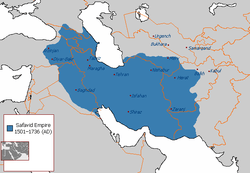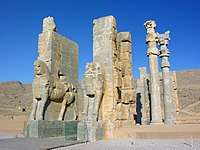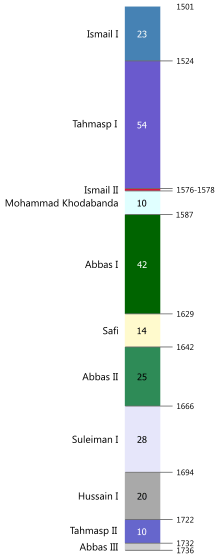সাফাভি রাজবংশ
সাফাভি রাজবংশ (ফার্সি: سلسلهٔ صفويان; আজারবাইজানি: Səfəvilər, صفویلر) ছিল পারস্যের সবচেয়ে গুরুত্বপূর্ণ রাজবংশগুলোর অন্যতম। একে প্রায় আধুনিক পারস্যের ইতিহাসের সূচনা হিসেবে বিবেচনা করা হয়।[16] মুসলিমদের পারস্য বিজয়ের পর এটি অন্যতম বৃহৎ পারস্য সাম্রাজ্য।[17][18][19][20] এই রাজবংশ বারো পন্থি শিয়া মতবাদকে রাষ্ট্রধর্ম হিসেবে প্রতিষ্ঠিত করে।[21] এটি মুসলিম ইতিহাসের অন্যতম গুরুত্বপূর্ণ সন্ধিক্ষণ হিসেবে বিবেচিত হয়। সাফাভি শাসন ১৫০১ থেকে ১৭২২ সাল পর্যন্ত স্থায়ী হয়, এরপর ১৭২৯ থেকে ১৭৩৬ সাল পর্যন্ত সংক্ষিপ্তকালের জন্য তা প্রতিষ্ঠা পেয়েছিল। সাম্রাজ্যের সর্বোচ্চ সীমায় আধুনিক ইরান, আজারবাইজান, বাহরাইন ও আর্মেনিয়া; জর্জিয়া, উত্তর ককেসাস, ইরাক, কুয়েত ও আফগানিস্তানের অধিকাংশ এবং তুরস্ক, সিরিয়া, পাকিস্তান, তুর্কমেনিস্তান ও উজবেকিস্তানের অংশ এর অন্তর্ভুক্ত ছিল। ইংরেজিতে ‘’গানপাউডার এম্পায়ার’’ বা ‘’বারুদ সাম্রাজ্য’’ বলে পরিচিত সাম্রাজ্যগুলোর মধ্যে এটি অন্যতম ছিল। অন্য সাম্রাজ্যগুলো ছিল সাফাভি সাম্রাজ্যের প্রতিদ্বন্দ্বী উসমানীয় সাম্রাজ্য ও মুঘল সাম্রাজ্য।
| পারস্যের সাফাভি রাজবংশ[1][2] | ||||||||||||||||||||||||||||||
| سلسلهٔ صفويان Ṣafawīyān Irân | ||||||||||||||||||||||||||||||
| ||||||||||||||||||||||||||||||
| ||||||||||||||||||||||||||||||
 সাফাভি রাজবংশের অবস্থান প্রথম শাহ আব্বাসের অধীনে সাফাভি সাম্রাজ্য | ||||||||||||||||||||||||||||||
| রাজধানী | তাবরিজ (১৫০১-১৫৫৫) কাজভিন (১৫৫৫–১৫৯৮) ইসফাহান (১৫৯৮–১৭৩৬) | |||||||||||||||||||||||||||||
| ভাষাসমূহ |
| |||||||||||||||||||||||||||||
| ধর্ম | বারোপন্থি শিয়া ইসলামa | |||||||||||||||||||||||||||||
| সরকার | ধর্মরাষ্ট্র রাজতন্ত্র | |||||||||||||||||||||||||||||
| শাহেনশাহ | ||||||||||||||||||||||||||||||
| - | ১৫০১–১৫২৪ | প্রথম ইসমাইল (প্রথম) | ||||||||||||||||||||||||||||
| - | ১৭৩২–১৭৩৬ | তৃতীয় আব্বাস (শেষ) | ||||||||||||||||||||||||||||
| আইন-সভা | আলোচনা সভা | |||||||||||||||||||||||||||||
| ইতিহাস | ||||||||||||||||||||||||||||||
| - | সাফিউদ্দিন আরদাবিলি কর্তৃক সাফাভিয়া প্রতিষ্ঠা | ১৩০১ | ||||||||||||||||||||||||||||
| - | সংস্থাপিত | ১৫০১ | ||||||||||||||||||||||||||||
| - | হুতাকি আক্রমণ | ১৭২২ | ||||||||||||||||||||||||||||
| - | নাদির শাহের জয় | ১৭২৬–২৯ | ||||||||||||||||||||||||||||
| - | ভাঙ্গিয়া দেত্তয়া হয়েছে | মার্চ ১৭৩৬ | ||||||||||||||||||||||||||||
| - | নাদির শাহের ক্ষমতালাভ | ১ অক্টোবর ১৭৩৬ | ||||||||||||||||||||||||||||
| আয়তন | বর্গ কি.মি. ( বর্গ মাইল) | |||||||||||||||||||||||||||||
| মুদ্রা | তুমান, আব্বাসি, শাহি.[14]
| |||||||||||||||||||||||||||||
| ||||||||||||||||||||||||||||||
| বর্তমানে অংশ | বর্তমানে অংশ
| |||||||||||||||||||||||||||||
| a State religion.[15] | ||||||||||||||||||||||||||||||
| সতর্কীকরণ: "মহাদেশের" জন্য উল্লিখিত মান সম্মত নয় | ||||||||||||||||||||||||||||||
| ইরানের ইতিহাস | ||||||||||||||||||||||||||||||||||||||||||||||||||||||||||||||||||||||||||||||
|---|---|---|---|---|---|---|---|---|---|---|---|---|---|---|---|---|---|---|---|---|---|---|---|---|---|---|---|---|---|---|---|---|---|---|---|---|---|---|---|---|---|---|---|---|---|---|---|---|---|---|---|---|---|---|---|---|---|---|---|---|---|---|---|---|---|---|---|---|---|---|---|---|---|---|---|---|---|---|
| ধারাবাহিকের একটি অংশ | ||||||||||||||||||||||||||||||||||||||||||||||||||||||||||||||||||||||||||||||
 | ||||||||||||||||||||||||||||||||||||||||||||||||||||||||||||||||||||||||||||||
|
পৌরাণিক ইতিহাস
|
||||||||||||||||||||||||||||||||||||||||||||||||||||||||||||||||||||||||||||||
|
||||||||||||||||||||||||||||||||||||||||||||||||||||||||||||||||||||||||||||||
|
||||||||||||||||||||||||||||||||||||||||||||||||||||||||||||||||||||||||||||||
|
||||||||||||||||||||||||||||||||||||||||||||||||||||||||||||||||||||||||||||||
|
||||||||||||||||||||||||||||||||||||||||||||||||||||||||||||||||||||||||||||||
|
||||||||||||||||||||||||||||||||||||||||||||||||||||||||||||||||||||||||||||||
|
সম্পর্কিত নিবন্ধ
|
||||||||||||||||||||||||||||||||||||||||||||||||||||||||||||||||||||||||||||||
|
| ||||||||||||||||||||||||||||||||||||||||||||||||||||||||||||||||||||||||||||||
সাফাভি শাহ

- প্রথম ইসমাইল ১৫০১–১৫২৪
- প্রথম তাহমাস্প ১৫২৪–১৫৭৬
- দ্বিতীয় ইসমাইল ১৫৭৬–১৫৭৮
- মুহাম্মদ খোদাবান্দ ১৫৭৮–১৫৮৭
- প্রথম আব্বাস ১৫৮৭–১৬২৯
- সাফি ১৬২৯–১৬৪২
- দ্বিতীয় আব্বাস ১৬৪২–১৬৬৬
- প্রথম সুলাইমান ১৬৬৬–১৬৯৪
- সুলতান প্রথম হুসাইন ১৬৯৪–১৭২২
- দ্বিতীয় তাহমাস্প ১৭২২–১৭৩২
- তৃতীয় আব্বাস ১৭৩২–১৭৩৬
আরও দেখুন
- পারস্যায়িত রাষ্ট্র
- শিয়া মুসলিম রাজবংশের তালিকা
- সাফাভি কর্তৃক ইরানের সুন্নি থেকে শিয়া মতে পরিবর্তন
- সাফাভি শাহদের মায়েদের তালিকা
তথ্যসূত্র
- "Safavid dynasty"। Britannica।
- "Safavid Persia"। Books। Google।
- Rudi Matthee, "Safavids" in Encyclopædia Iranica, accessed on April 4, 2010. "The Persian focus is also reflected in the fact that theological works also began to be composed in the Persian language and in that Persian verses replaced Arabic on the coins." "The political system that emerged under them had overlapping political and religious boundaries and a core language, Persian, which served as the literary tongue, and even began to replace Arabic as the vehicle for theological discourse".
- Ronald W Ferrier, The Arts of Persia. Yale University Press. 1989, p. 9.
- John R Perry, "Turkic-Iranian contacts", Encyclopædia Iranica, January 24, 2006: "...written Persian, the language of high literature and civil administration, remained virtually unaffected in status and content"
- Arnold J. Toynbee, A Study of History, V, pp. 514-15. excerpt: "in the heyday of the Mughal, Safawi, and Ottoman regimes New Persian was being patronized as the language of literae humaniores by the ruling element over the whole of this huge realm, while it was also being employed as the official language of administration in those two-thirds of its realm that lay within the Safawi and the Mughal frontiers"
- Ruda Jurdi Abisaab. "Iran and Pre-Independence Lebanon" in Houchang Esfandiar Chehabi, Distant Relations: Iran and Lebanon in the Last 500 Years, IB Tauris 2006, p. 76: "Although the Arabic language was still the medium for religious scholastic expression, it was precisely under the Safavids that hadith complications and doctrinal works of all sorts were being translated to Persian. The 'Amili (Lebanese scholars of Shi'i faith) operating through the Court-based religious posts, were forced to master the Persian language; their students translated their instructions into Persian. Persianization went hand in hand with the popularization of 'mainstream' Shi'i belief."
- Price, Massoume (২০০৫)। Iran's Diverse Peoples: A Reference Sourcebook। ABC-CLIO। পৃষ্ঠা 66। আইএসবিএন 978-1-57607-993-5।
The Shah was a native Turkic speaker and wrote poetry in the Azerbaijani language.
- Ferrier, RW, A Journey to Persia: Jean Chardin's Portrait of a Seventeenth-century Empire, p. ix.
- The New Encyclopedia of Islam, Ed. Cyril Glassé, (Rowman & Littlefield Publishers, 2008), 449.
- "SAFAVID DYNASTY"। Encyclopædia Iranica।
- Helen Chapin Metz. Iran, a Country study. 1989. University of Michigan, p. 313.
- Emory C. Bogle. Islam: Origin and Belief. University of Texas Press. 1989, p. 145.
- Stanford Jay Shaw. History of the Ottoman Empire. Cambridge University Press. 1977, p. 77.
- Andrew J. Newman, Safavid Iran: Rebirth of a Persian Empire, IB Tauris (March 30, 2006).
- RM Savory, Safavids, Encyclopedia of Islam, 2nd ed.
আরও পড়ুন
- M.I. Marcinkowski (tr.),Persian Historiography and Geography: Bertold Spuler on Major Works Produced in Iran, the Caucasus, Central Asia, India and Early Ottoman Turkey, M. Ismail Marcinkowski, Singapore: Pustaka Nasional, 2003, আইএসবিএন ৯৯৭১-৭৭-৪৮৮-৭.
- M.I. Marcinkowski (tr., ed.),Mirza Rafi‘a's Dastur al-Muluk: A Manual of Later Safavid Administration. Annotated English Translation, Comments on the Offices and Services, and Facsimile of the Unique Persian Manuscript, M. Ismail Marcinkowski, Kuala Lumpur, ISTAC, 2002, আইএসবিএন ৯৮৩-৯৩৭৯-২৬-৭.
- M.I. Marcinkowski,From Isfahan to Ayutthaya: Contacts between Iran and Siam in the 17th Century, M. Ismail Marcinkowski, Singapore, Pustaka Nasional, 2005, আইএসবিএন ৯৯৭১-৭৭-৪৯১-৭.
- Hakim Syed Zillur Rahman, "Safavi Ahad Main Ilm Tashreeh Ka Mutala (a book in Urdu on Studies of History of anatomy during Safavid dynasty), Tibbi Academy, Aligarh, India, 1983, 96 pp.
- "The Voyages and Travels of the Ambassadors", Adam Olearius, translated by John Davies (1662),
বহিঃসংযোগ
| উইকিমিডিয়া কমন্সে সাফাভি রাজবংশ সংক্রান্ত মিডিয়া রয়েছে। |
- History of the Safavids on Iran Chamber
- "Safavid dynasty", Encyclopædia Iranica by Rudi Matthee
- The History Files: Rulers of Persia
- BBC History of Religion
- Iranian culture and history site
- Artistic and cultural history of the Safavids from the Metropolitan Museum of Art
- History of Safavid art
- A Study of the Migration of Shi'i Works from Arab Regions to Iran at the Early Safavid Era.
- Why is Safavid history important? (Iran Chamber Society)
- Historiography During the Safawid Era
- NEWMAN, Andrew J. Safavid Iran - Rebirth of a Persian Empire. New York: I.B. Tauris, 2009.
- "IRAN ix. RELIGIONS IN IRAN (2) Islam in Iran (2.3) Shiʿism in Iran Since the Safavids: Safavid Period", Encyclopædia Iranica by Hamid Algar

